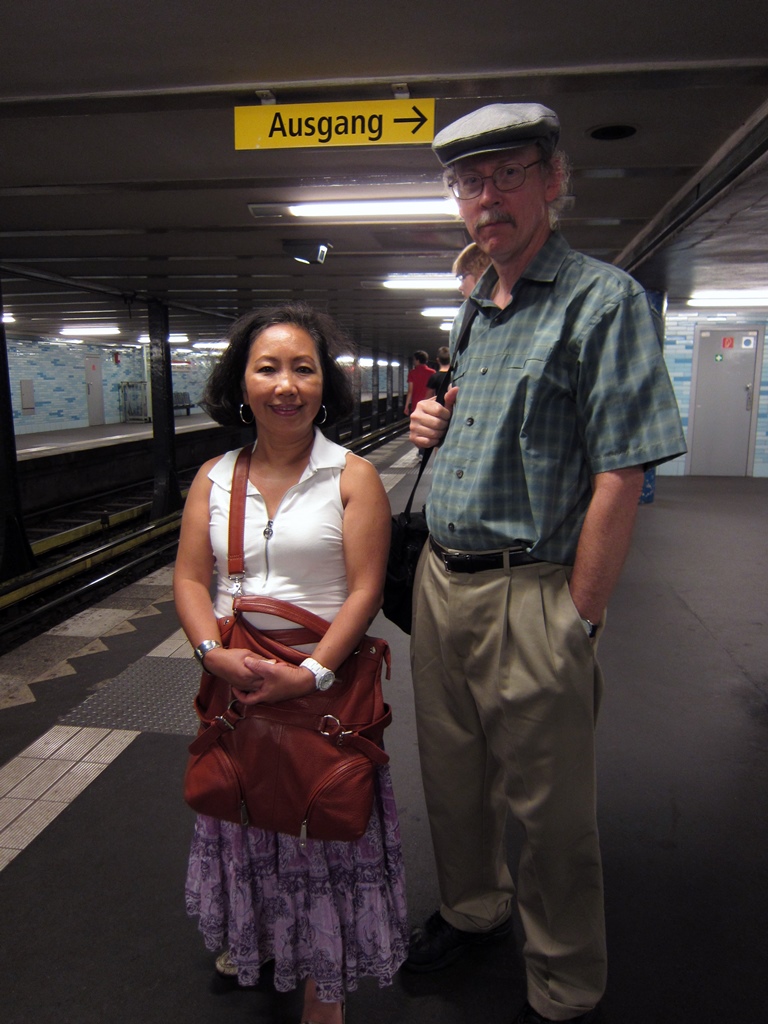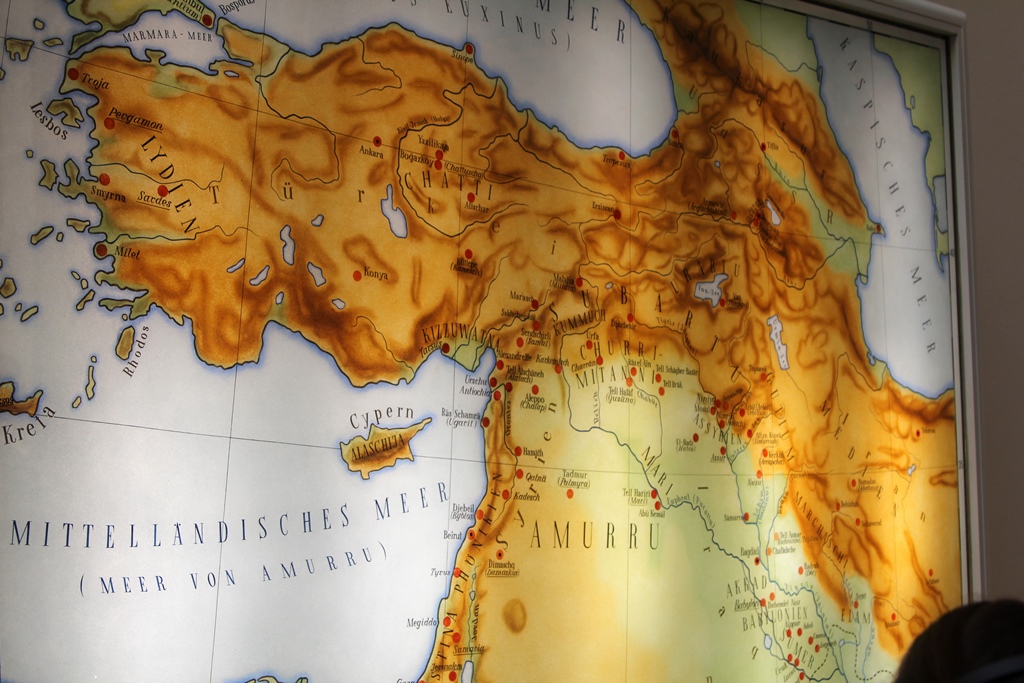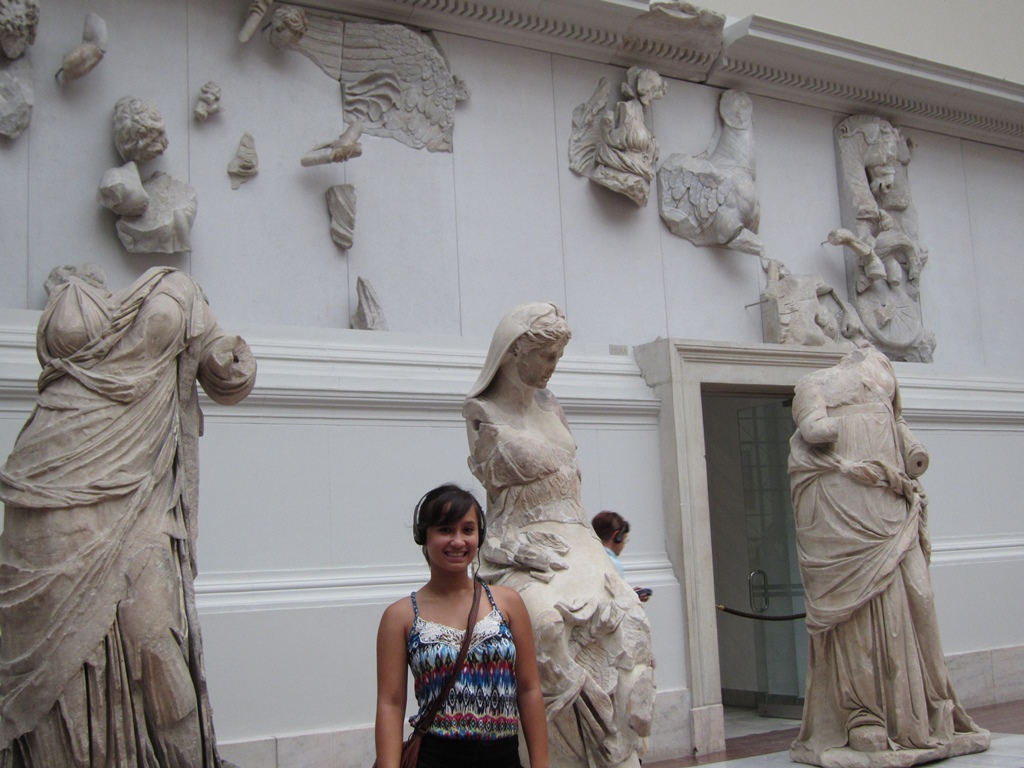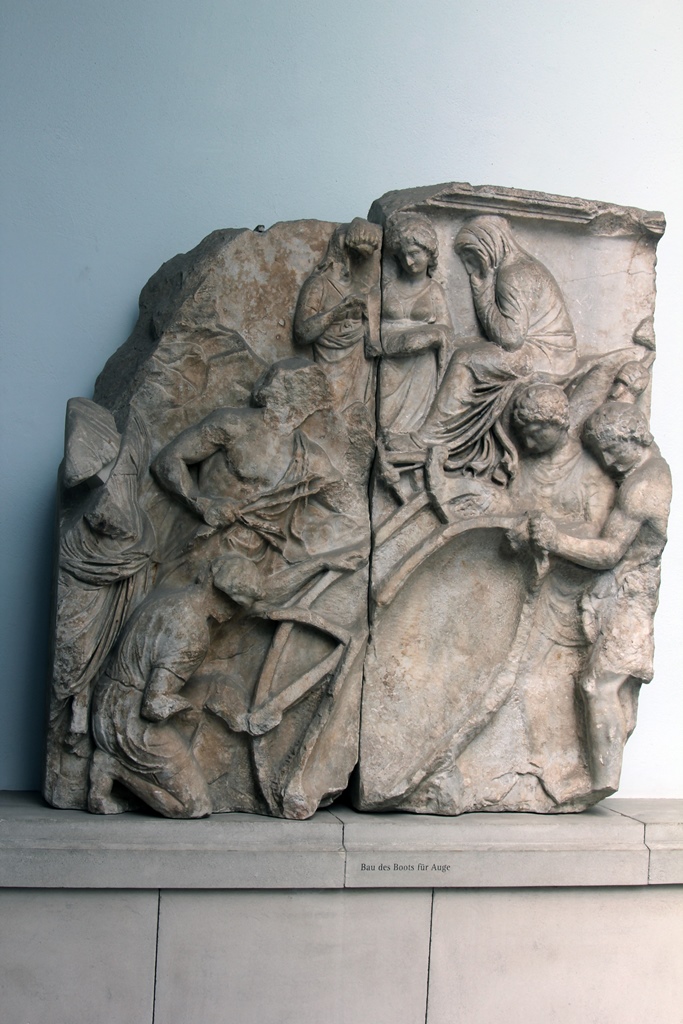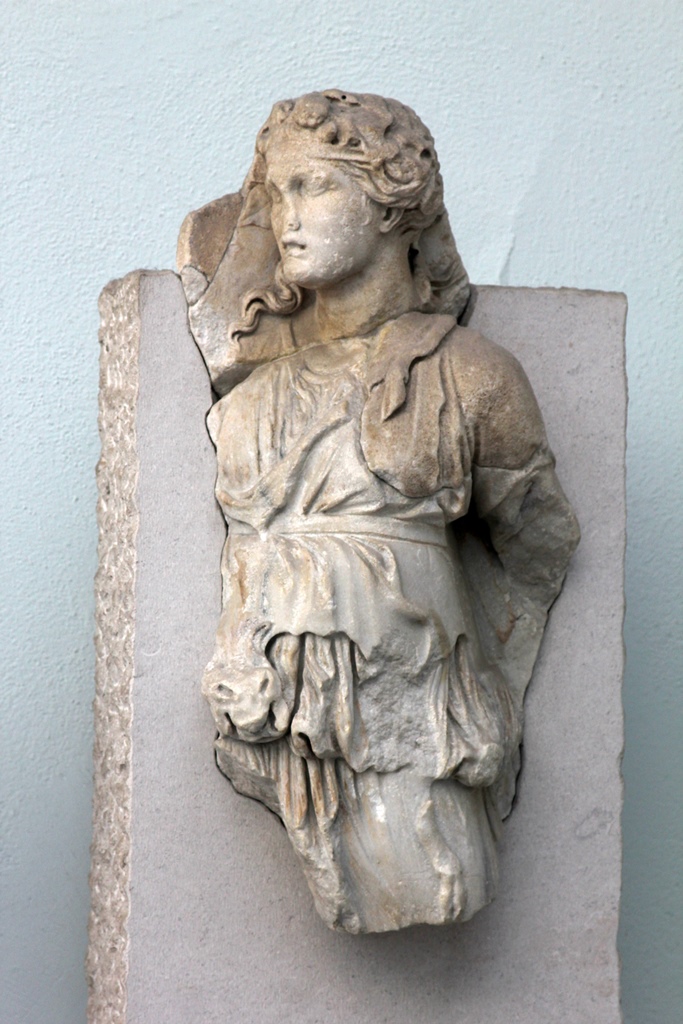Nella and Bob Wait for a Train
The next morning found us back in our local U-Bahn station. Our intention was to visit
the Pergamon Museum,
located (like the Neues Museum and the Berliner Dom) on the Museumsinsel. This being
the case, we had another look at the same subway stations we’d seen the day before. We
got off at the same one, crossed the same bridge over the Spree, walked past the front
of the Neues Museum and followed signs through a construction area to the entrance of the
Pergamon Museum.
Turkey
The city of Pergamon, located in the far west of what is now Turkey, not far from the
site of the fabled city of Troy, was the capital of the kingdom of Pergamon, which
existed from 282 to 133 B.C. Before the kingdom was established, its territory was
owned by Greeks and Persians, and after the kingdom had lived out its years, it became
the property (like pretty much everything else) of the Roman Empire. For awhile the
kingdom enjoyed a certain amount of glory, as a result of choosing its friends well
(mainly Rome), during wars against Macedon. Pergamon acquired some wealth and some
power, and found itself aspiring to be like some of the more famous cities of the
ancient world. A library was established which became second in reputation only to the
library at Alexandria in Egypt. Parchment was invented for this library, as an
alternative to papyrus. A hill in the city was repurposed as Pergamon’s very own
Acropolis, modeled after the more well-known Acropolis in Athens. The hill was
terraced, and a number of monumental structures were built, including the library.
After some good years under Roman rule, things turned south for Pergamon. Earthquakes
and Goths happened, as did sackings by other invading armies. Pergamon became less
important and was eventually largely forgotten. The ruins of the structures remained
on top of the hill, and the locals sometimes used the stone for other purposes, including
for structures of their own, or sometimes just for burning, in order to extract lime. In
the 19th Century, this is where the Germans came in.
In the 1860s a German engineer named Carl Humann came across the ruins on the Pergamon
Acropolis and urged their preservation, seeing that they were in danger. Some fragments
of a frieze were sent to Berlin; they were added to the collection at the Altes Museum
but did not otherwise receive any special attention. Not until 1877, anyway, when a man
named Alexander Conze became the new director of the sculpture collection at the Berlin
museums. Conze saw a connection between the frieze fragments and a description in an
ancient text of a large altar at Pergamon.
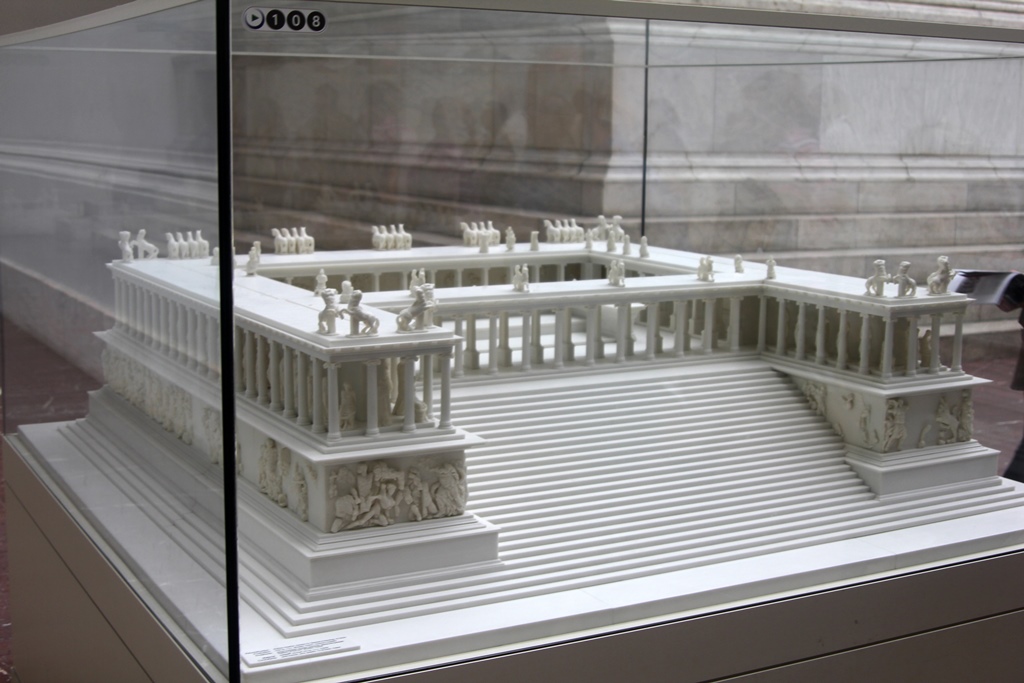
Model of Pergamon Altar
Anxious for the newly-united Germany to make its mark in the archeological world, the museum
leaders set in motion a major excavation effort at the Pergamon Acropolis, in cooperation
with the Ottoman Empire, whose territory included Turkey at the time. It was agreed that the
unearthed fragments would be sent to Germany and become part of the antiquities collection of
the Berlin museums.
The fragments received in Berlin were initially displayed in the already-crowded Altes Museum.
This was not an ideal way of displaying the pieces in any kind of coherent fashion, so it was
decided that a museum should be built specifically for display of the Pergamon artifacts. A
museum was built in the final years of the 19th Century, and was opened in 1901. As it turned
out the new museum was too small; there was also a problem with its foundation, so the museum
had to be demolished in 1908. Construction of a more appropriate museum started, but there
were delays caused by World War I and the many problems (including hyperinflation) that
occurred in the post-war years. But the new museum was finally completed and opened in 1930.
World War II brought its own problems (the altar fragments were removed and kept in safer
places, but many were discovered and “liberated” by the Red Army, and found their way to the
Hermitage Museum in Leningrad), but by the 1990s most of the fragments had been reunited at
the museum. At this point an extensive restoration was found to be necessary, as the previous
restoration involved some measures (e.g. iron clamps which had started to rust) which were now
becoming dangerous to the artifacts. The restoration was lengthy and expensive, but the
results were unveiled in 2004. The country of Turkey has asked that the artifacts (and
others) be returned to them, but the viewpoint of Germany (and the bulk of the international
community) has been that a deal’s a deal. The foundation of the altar remains in Turkey, along
with some wall fragments and some frieze fragments that were found later.
The Pergamon Museum is arranged so that the first thing a visitor sees is the reconstructed
western façade of the Pergamon Altar. The Altar was a monumental structure, 117 feet in width
(the central stairway of the western face occupies 65 feet of this) and 27 feet in height. The
Altar was roughly square in shape, but no attempt has been made to rebuild the entire structure
beyond the western façade.
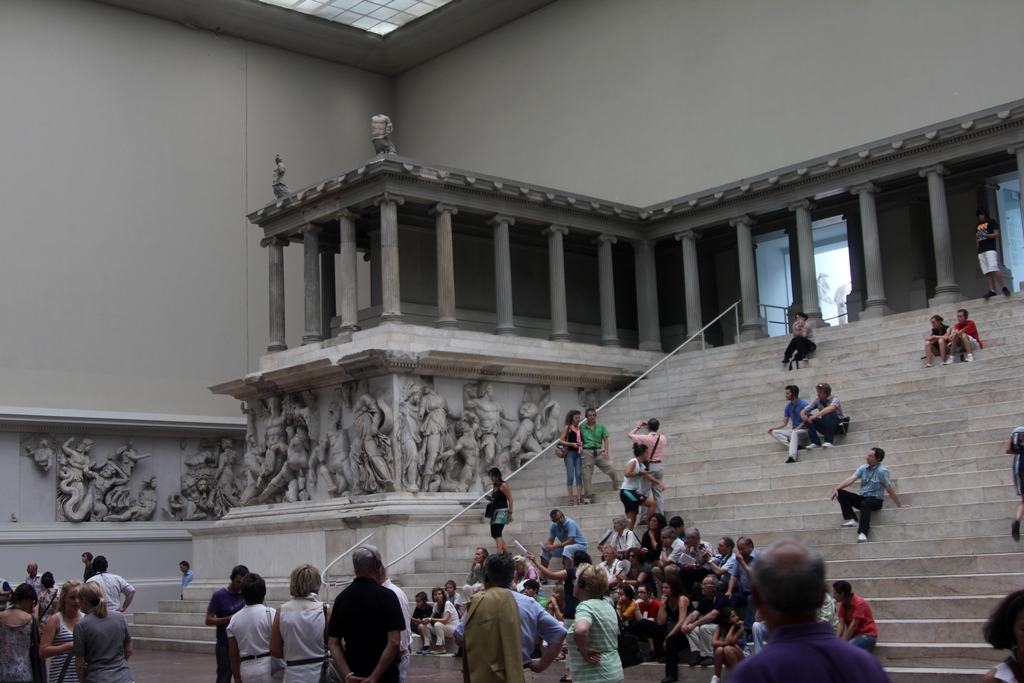
Pergamon Altar, Northern "Arm"
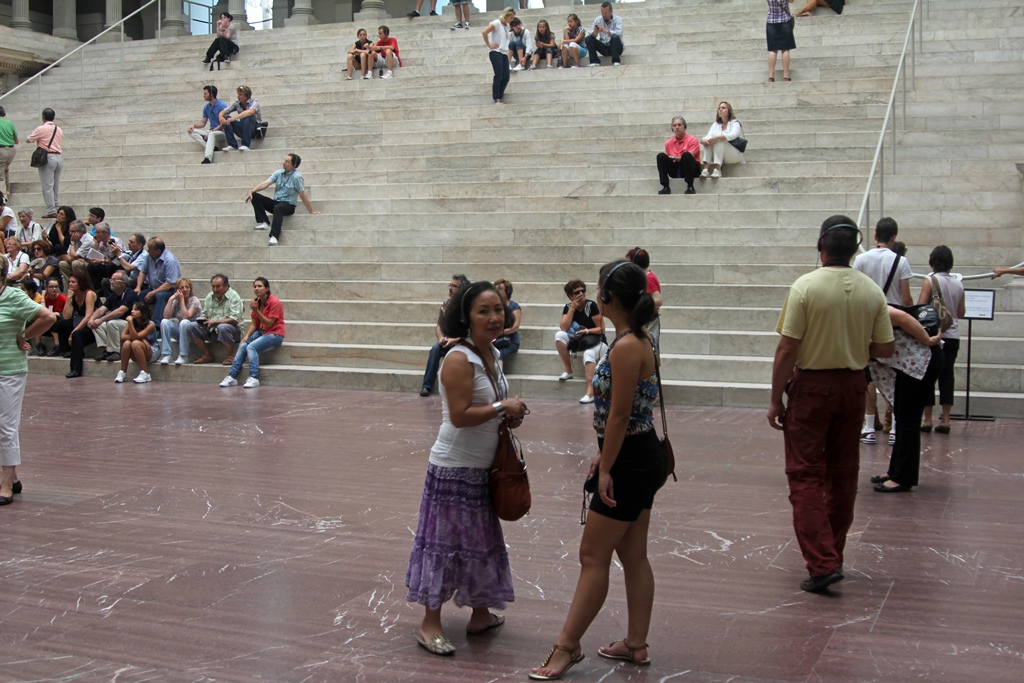
Nella and Connie and Stairs
There are two extensive friezes associated with the Altar, and attempts have been made
to reconstruct both of them, though many pieces are damaged or missing. The larger of
the two once wrapped around the base of the Altar (interrupted by the stairway), and
is 370 feet long. As the entire Altar has not been reconstructed, the portions that
were not on the western façade have been arranged around the interior of the large room
in front of the façade. This frieze is known as the Gigantomachy frieze, and depicts a
great deal of fighting between Greek gods and the reptilian-footed giants that were
children of the primordial goddess Gaia. It is the second-longest surviving frieze from
Greek antiquity, after the frieze from the Parthenon in Athens.

Stairs, South Arm, South Frieze

North Arm, Figures from Altar Area
Connie and Figures from Altar Area
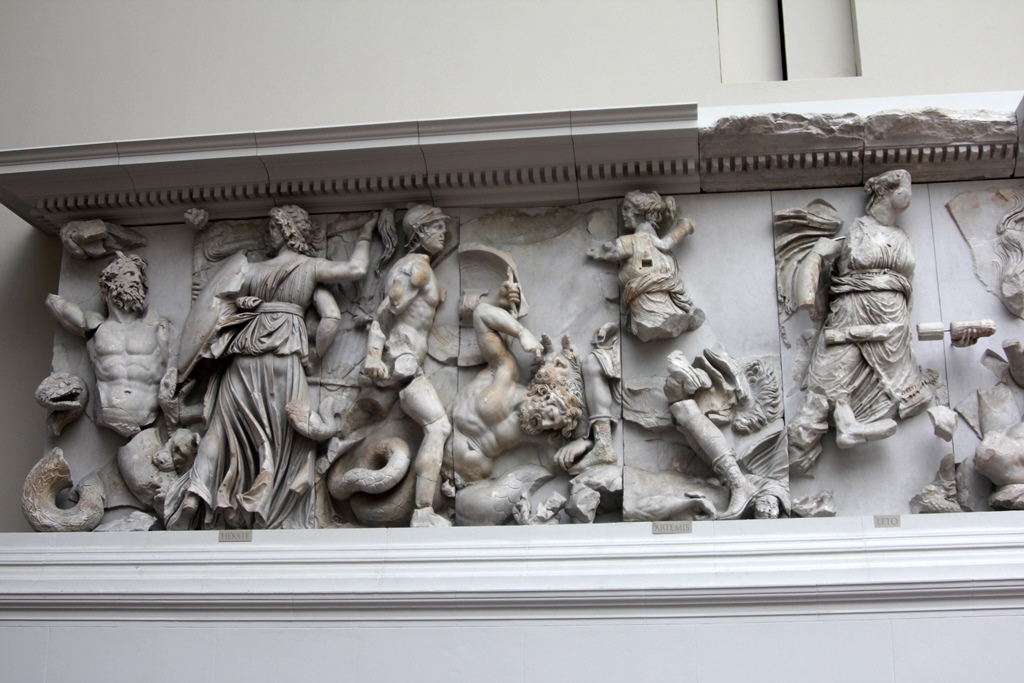
East Frieze - Hecate vs. Klytios, Artemis vs. Otos, Leto vs. a Giant
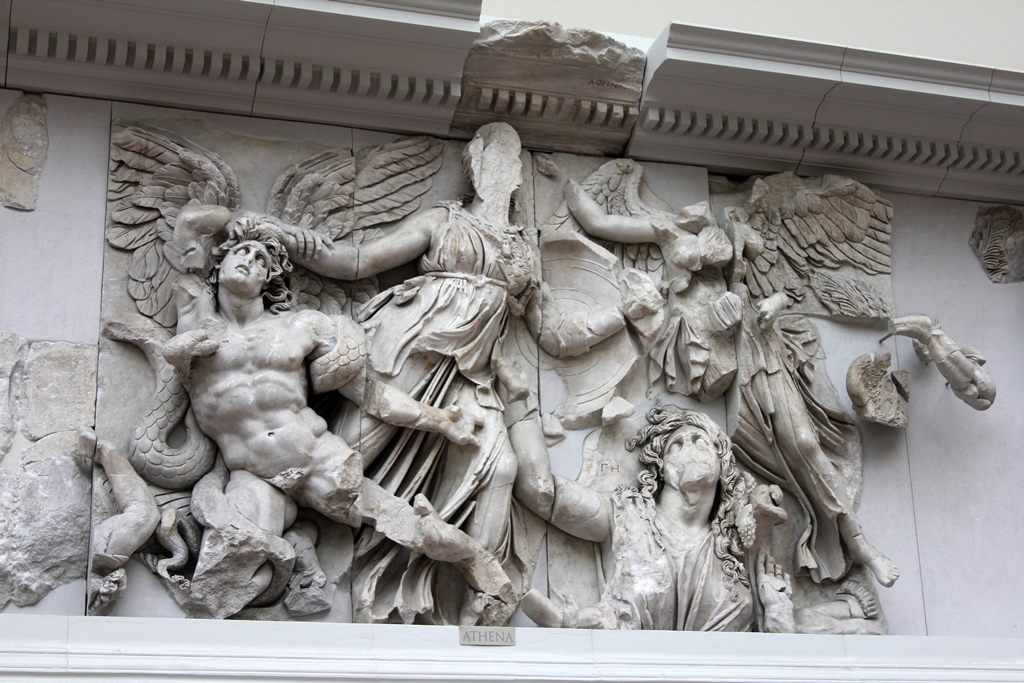
East Frieze - Athena and Nike vs. Alkyoneus, with Gaia Rising
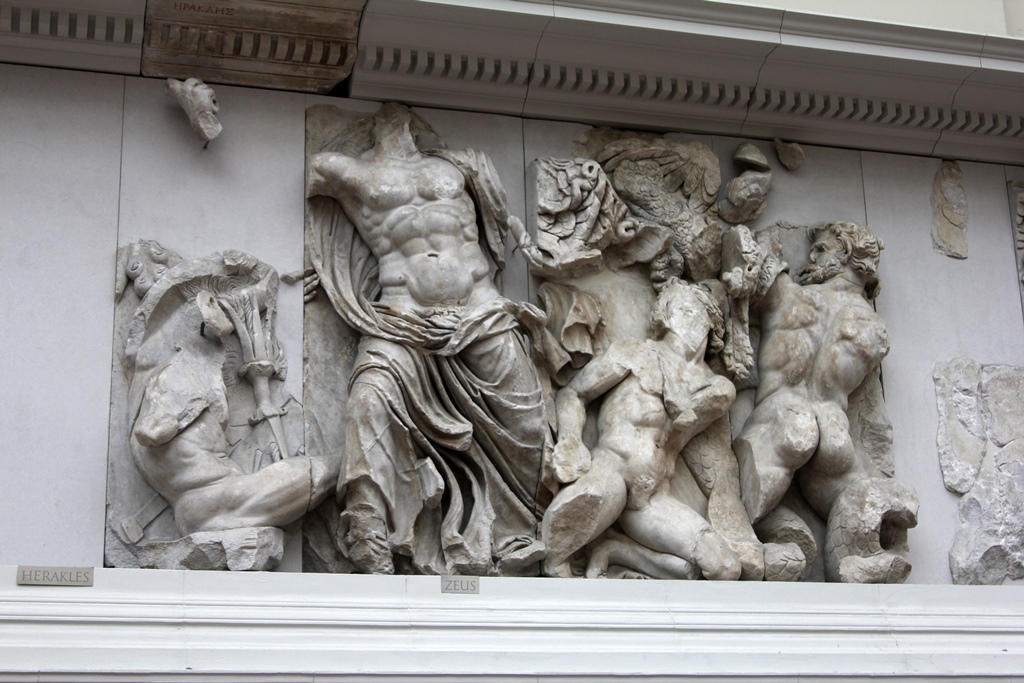
East Frieze - Heracles and Zeus vs. Porphyrion and Giants
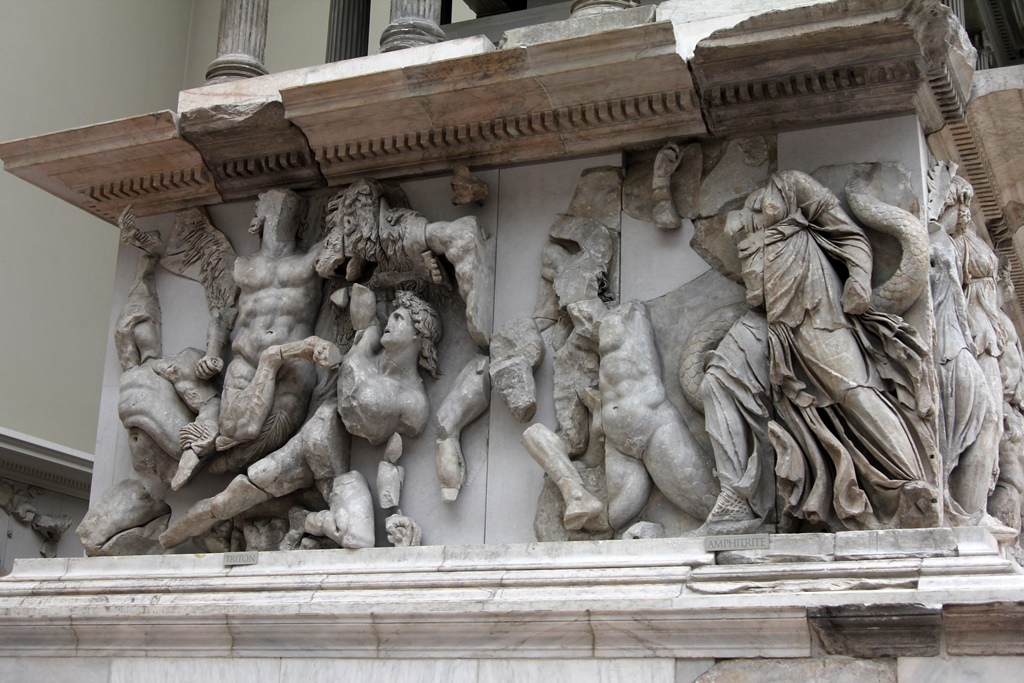
West Frieze - Triton and Amphitrite vs. Giants
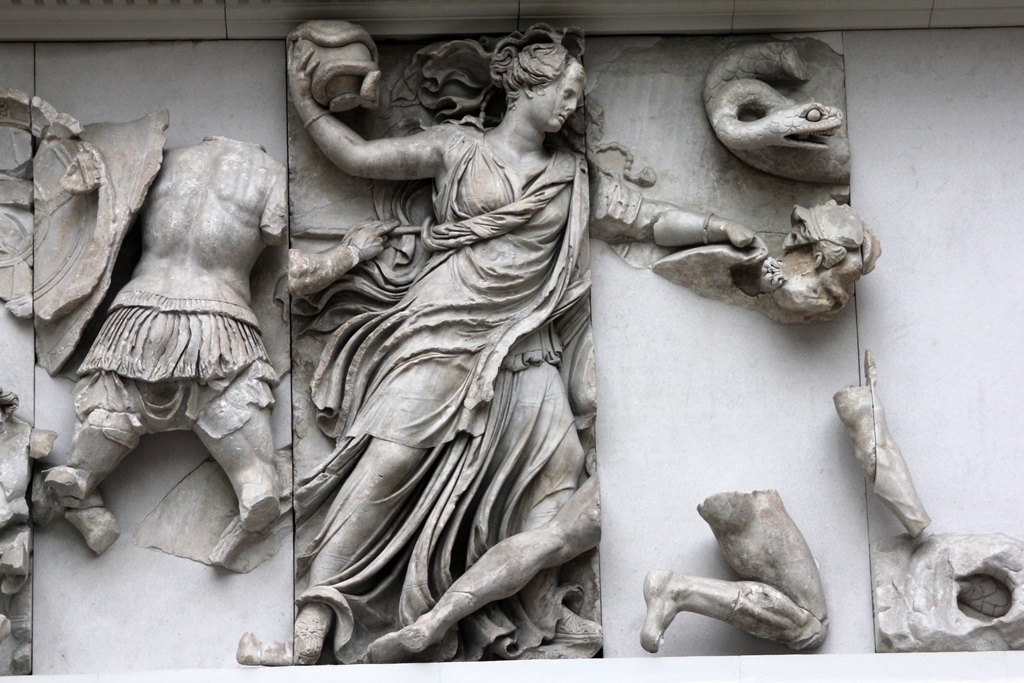
North Frieze - Erinye Throwing a Snake Vessel

North Frieze, North Arm of Altar
One has to climb the wide stairway to see the second frieze, which is arranged around
the inside of a room at the top, as it is thought to have been when first constructed.
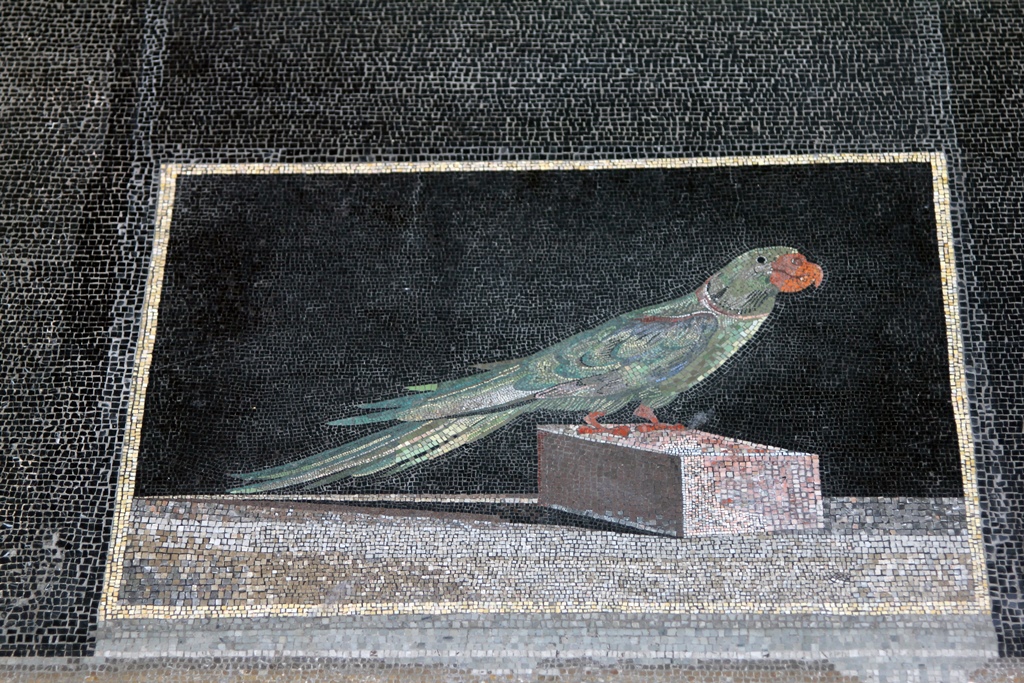
Parrot Mosaic on Floor, Telephus Room (160-150 B.C.)

Floor Mosaic, Telephus Room
This frieze depicts the life of the mythological Greek hero Telephus, a son of Heracles
(the Greek name for Hercules), and the legendary founder of the city of Pergamon. There
are many variations on the story, but it goes roughly like this:
A king named Aleus is told by an oracle that he will someday be overthrown by his
grandson. He doesn’t have a grandson yet, but he has a daughter named Auge, so he makes
her a virginal priestess of Athena and sends her off to a temple. One day the hero
Heracles happens to be passing through, and nine months later Auge gives birth to a son
named Telephus. Aleus is not pleased, and sets both Auge and Telephus adrift in
separate small boats to die. Except they don’t die – Auge lands in a kingdom called
Mysia, and is adopted by its king, while Telephus is found and rescued by Heracles, who
has him raised by nymphs.
Carpenters Build a Boat to Cast Auge Adrift
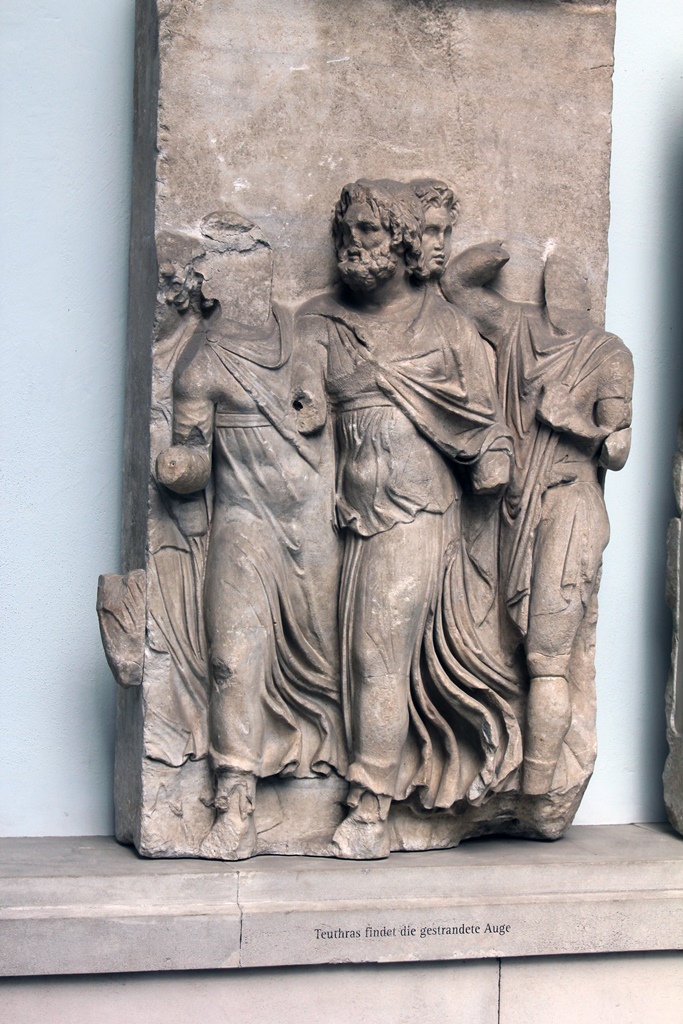
King Teuthras Finds the Stranded Auge
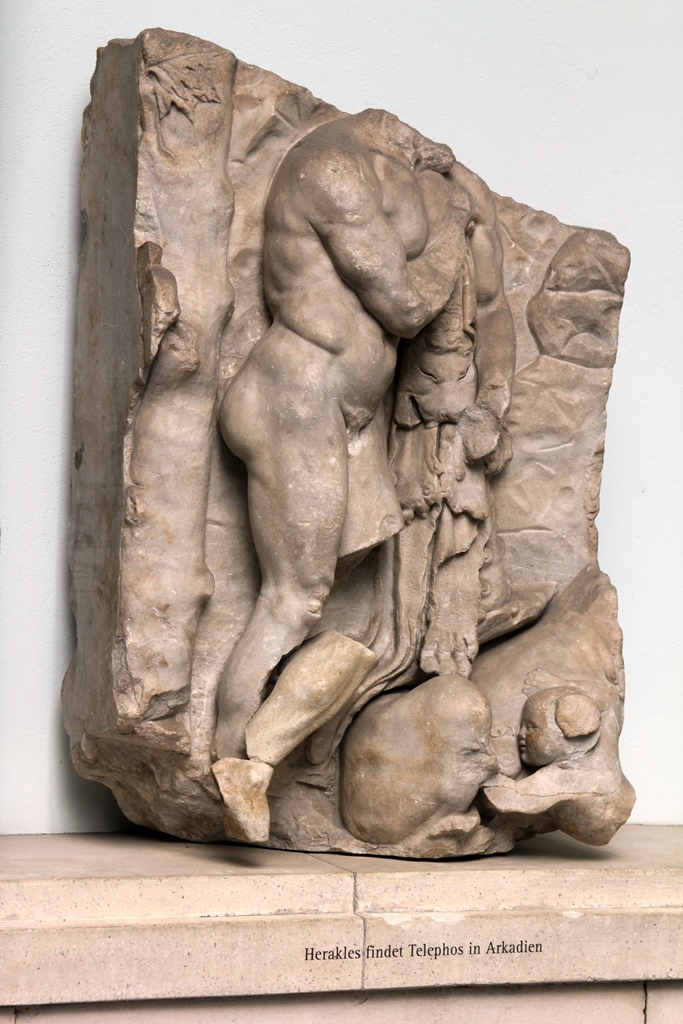
Heracles Finds Telephus
Telephus grows up and eventually goes off to seek his fortune. He lands in Mysia
(of all places), and helps the king win a battle. The king is grateful, and gives
Telephus his adopted daughter to marry. The wedding takes place, but on the wedding
night Auge and Telephus somehow become aware that they are mother and son (there are
different versions of how this happens), and the marriage is undone in the nick of
time. Instead Telephus marries an amazon named Hiera and eventually becomes the king
of Mysia.
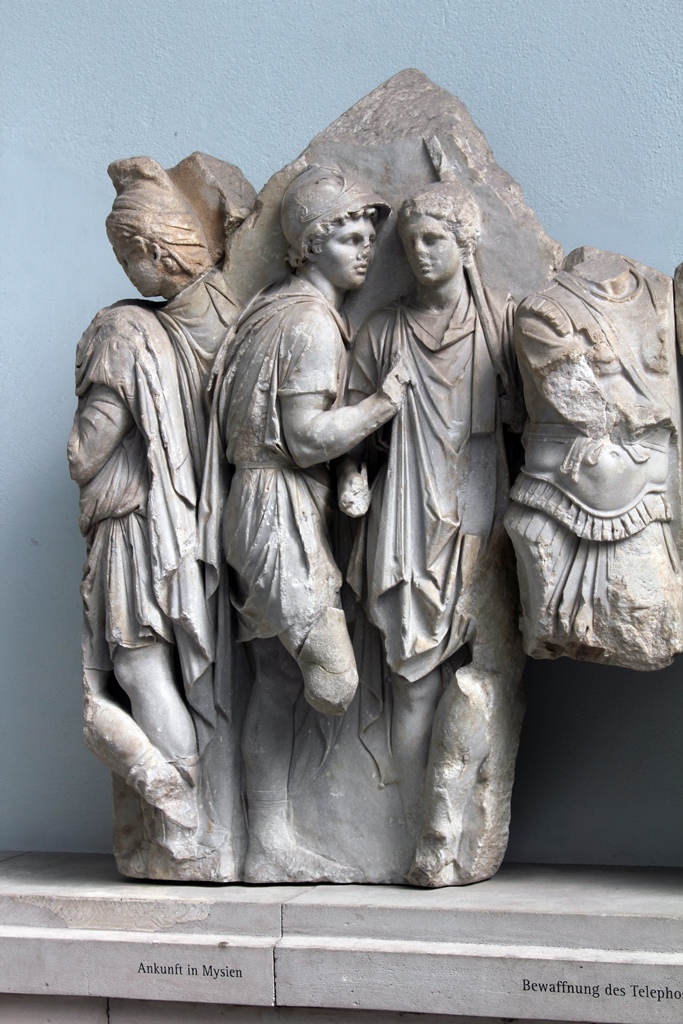
Telephus Arrives in Mysia
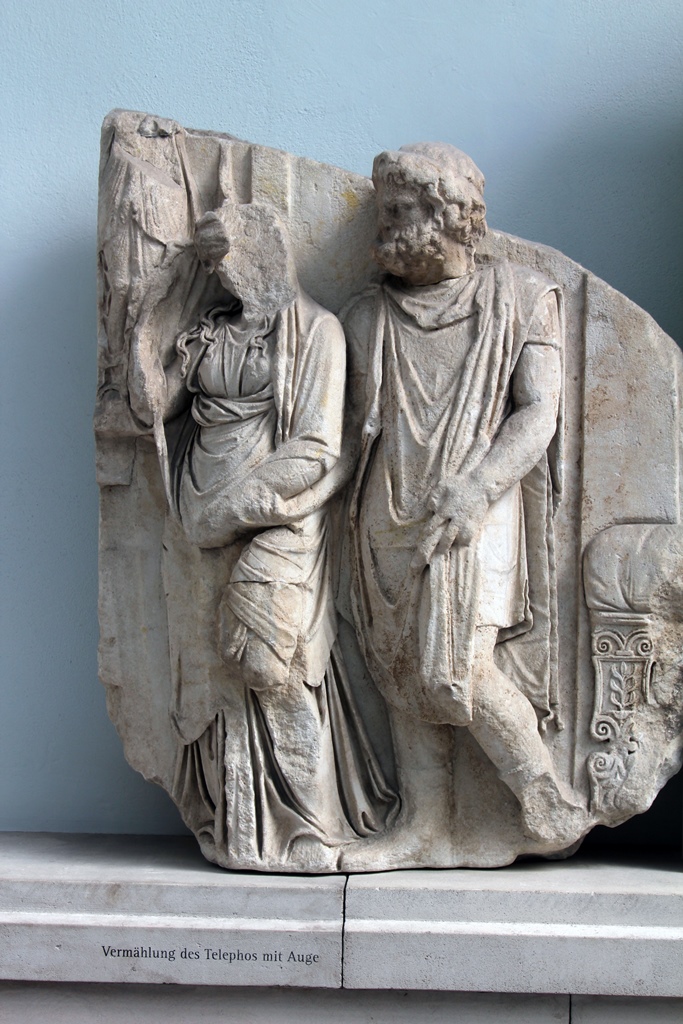
Wedding of Telephus with Auge
One day a Greek army on its way to Troy passes through Mysia, and they somehow
start fighting with the Mysians. The wife of Telephus is killed, and Telephus kills
the king of Thebes. The greek hero Achilles wounds Telephus with the help of the
god Dionysus, inflicting a wound that won’t heal. Telephus consults an oracle, who
tells him that Achilles can heal the wound. Telephus goes to Achilles in Argos and
tells him how to get to Troy, and in return his wound is healed.
Telephus Consults an Oracle
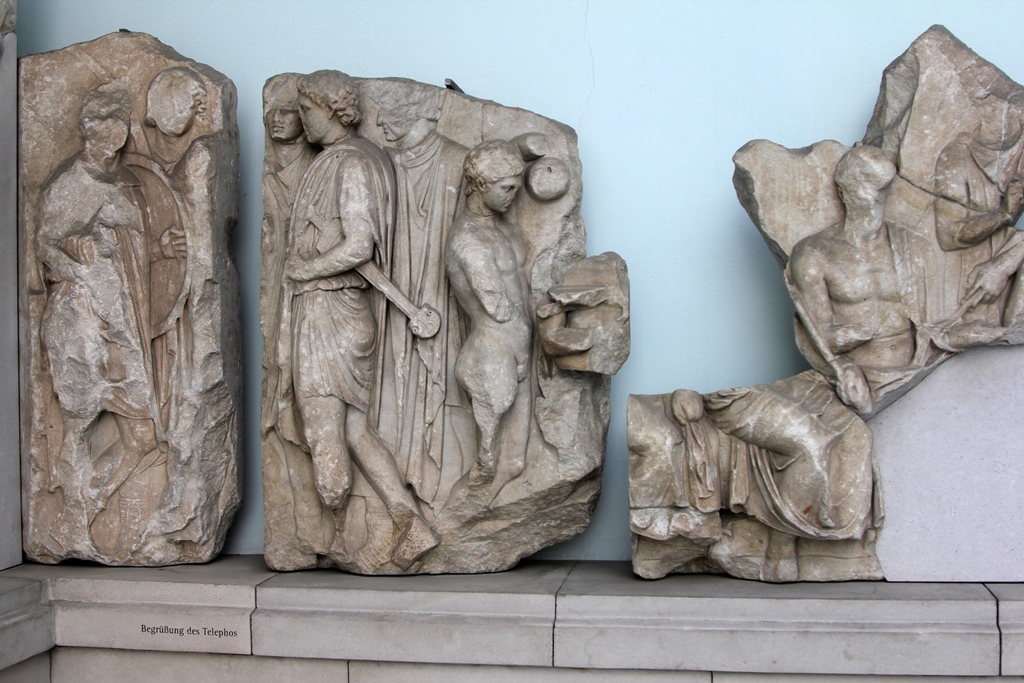
Telephus is Welcomed in Argos
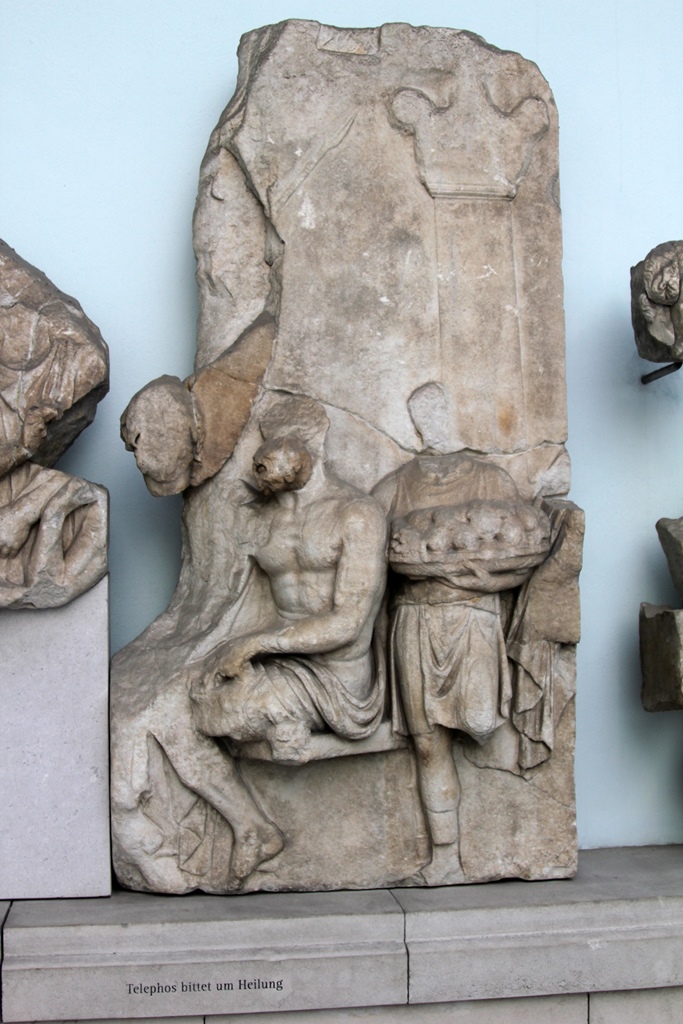
Telephus Asks to be Healed
There is more (including Telephus killing his grandfather in battle), but this
isn’t depicted in the frieze as it exists in Berlin. Instead, there are some
panels depicting the founding of cults in Pergamon.
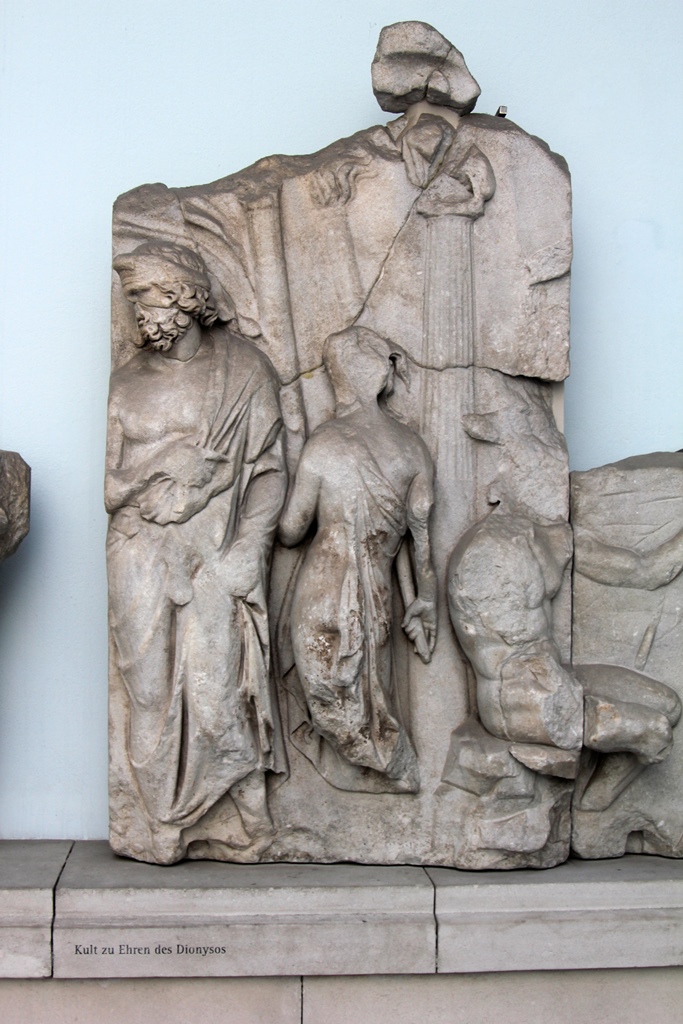
Founding of a Cult to Honor Dionysus
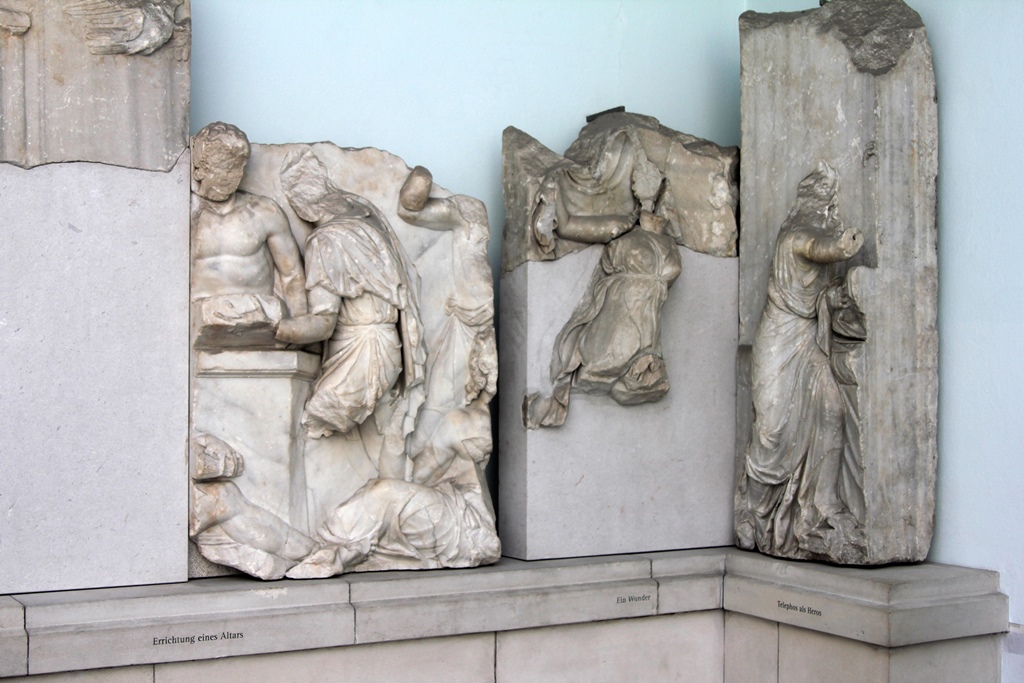
Women Hurry to View the Hero Telephus
Back down the stairs and to the right of the room with the Altar is a room with
miscellaneous artifacts from the Greek Hellenistic period, including some from
the Pergamon Acropolis.
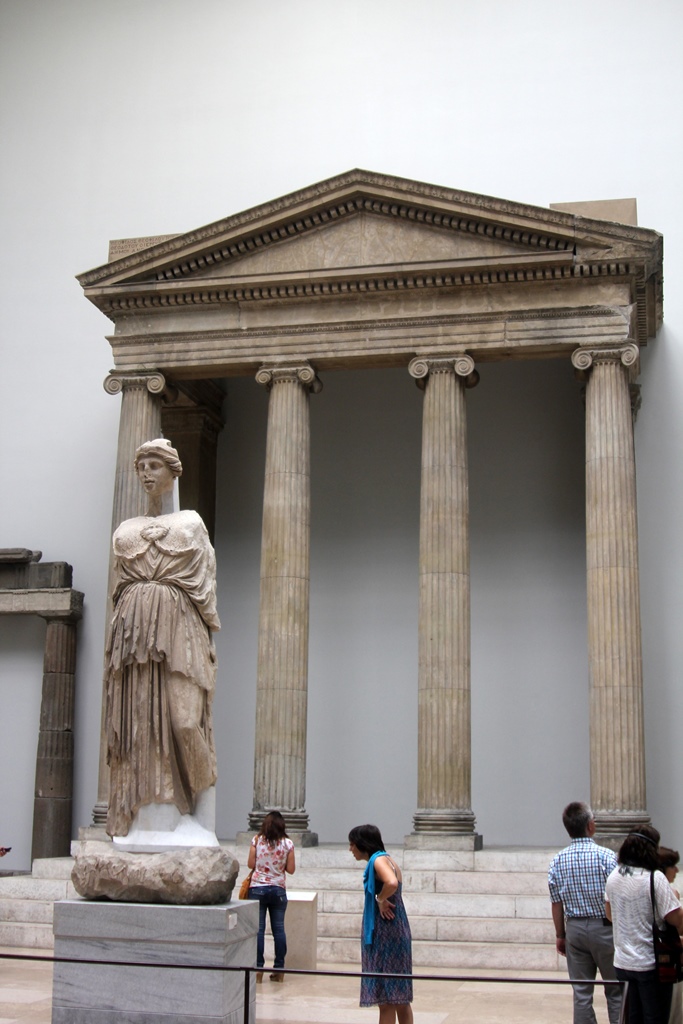
Portico and Statue of Athena
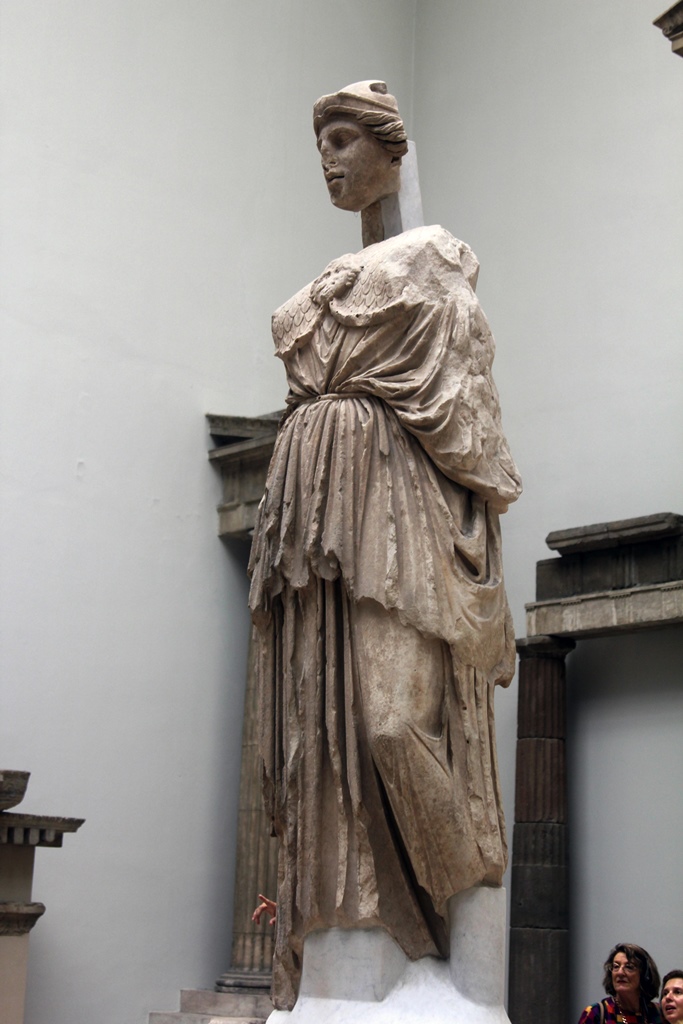
Statue of Athena, from Pergamon Library (2nd C. B.C.)
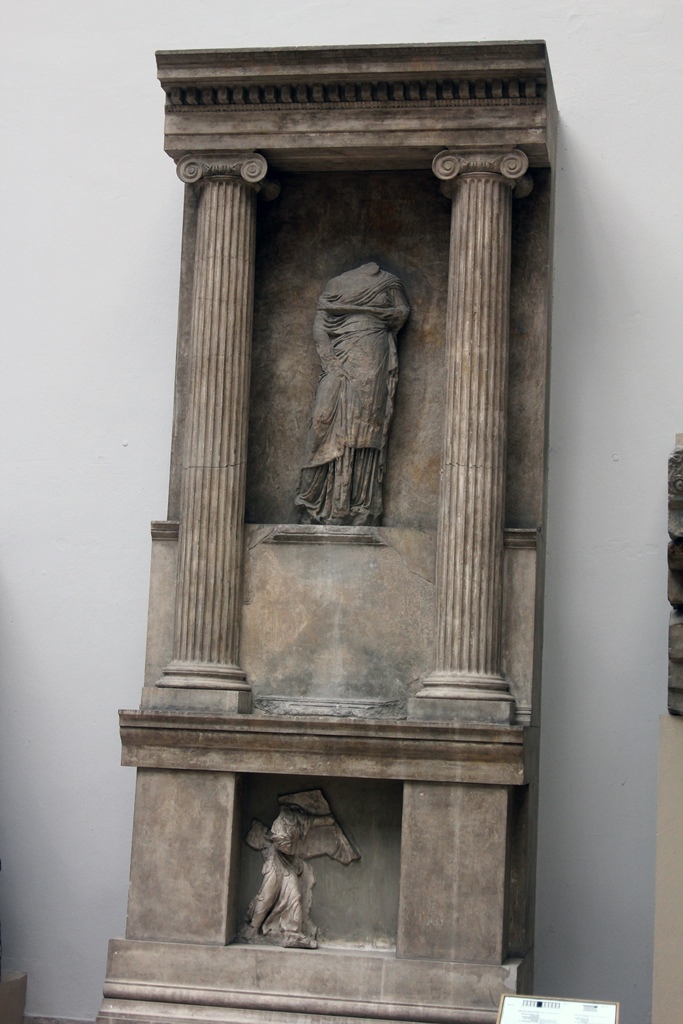
Section of Altar of Athena Polias (2nd C. B.C.)

Athena Statue, Portico, Columns
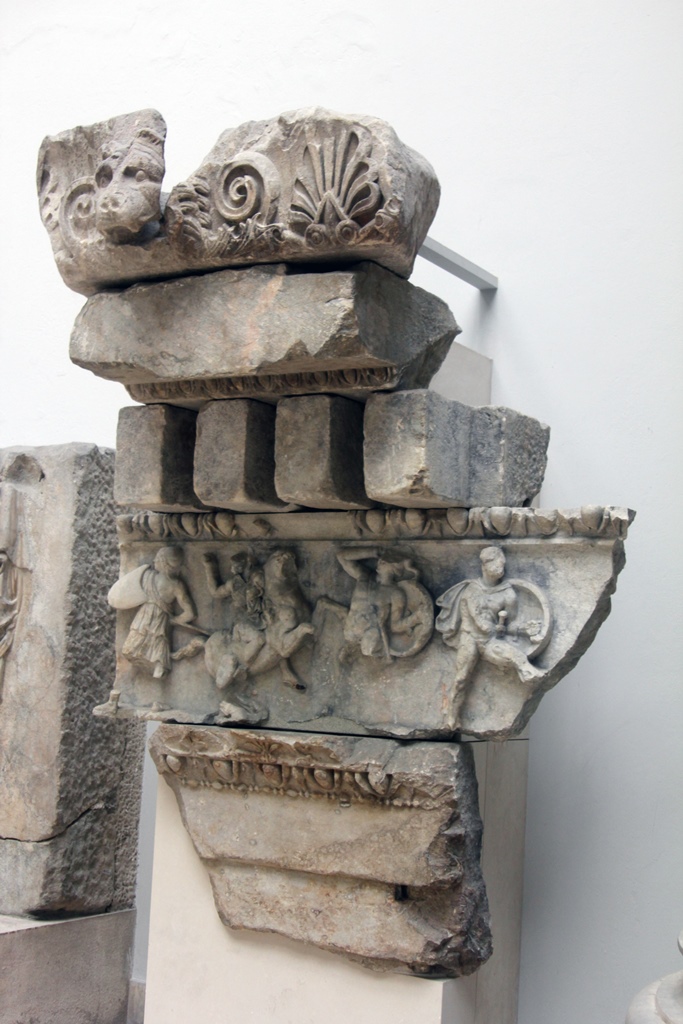
Entablature from Temple of Artemis, Magnesia
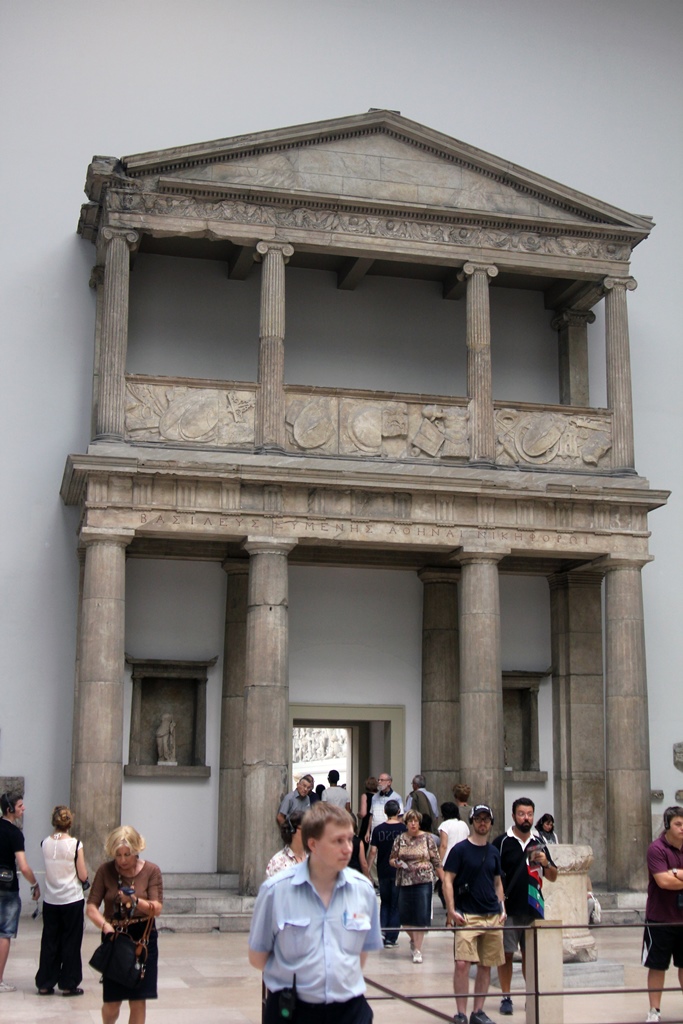
Reconstructed Entranceway to Athena Temple
Altar Section, Entablature, Columns, Entranceway
Crossing back through the room with the Pergamon Altar and through a door on the
opposite side of the room, one enters a room housing another monumental structure,
the Miletus Market Gate.

Orpheus Mosaic and Miletus Market Gate
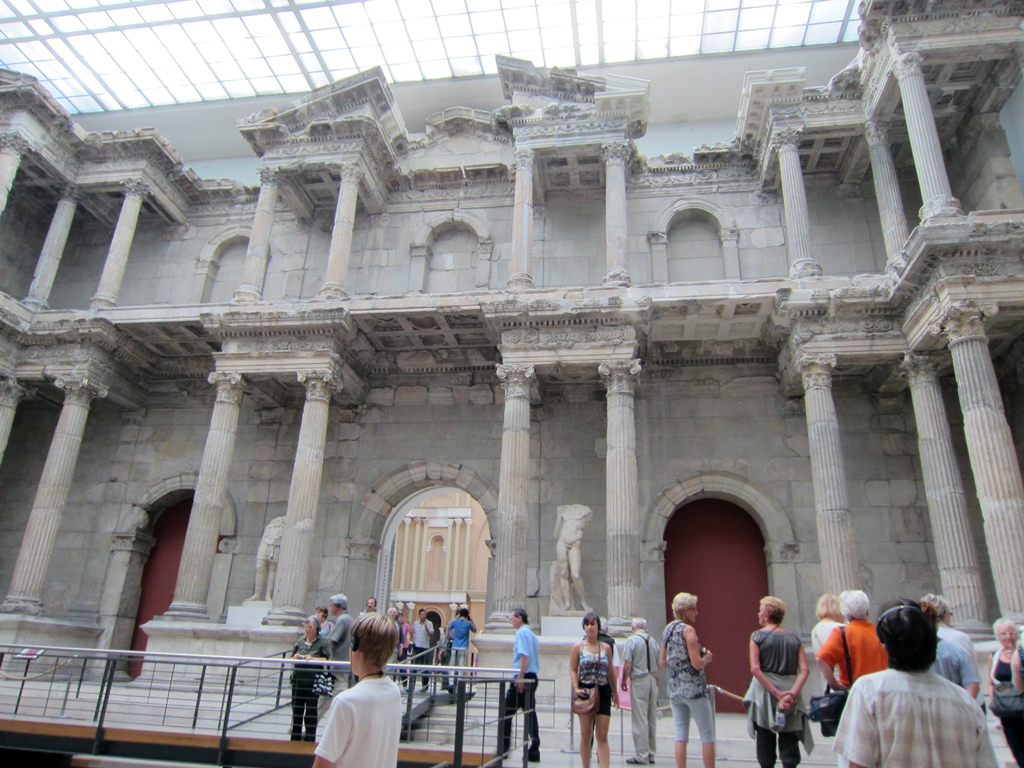
Connie and Market Gate
Miletus was another city on the Turkish west coast, located to the south of
Pergamon, at the mouth of the Meander River. The Market Gate was built in the
2nd Century A.D., when the region was under Roman rule, probably during the
reign of the emperor Hadrian. It’s 98 feet wide and 52 feet tall. The gate
was destroyed by an earthquake in the 10th or 11th Century A.D., and the city
of Miletus was abandoned a few centuries later, as the silting up of the Meander
made Miletus an inland city and no longer a port (it’s now about six miles from
the coastline). German excavation of the area took place from 1899 to 1911, and
fragments of the gate were sent back to Berlin. After a demonstration involving
models, Kaiser Wilhelm II himself ordered that the gate be reconstructed in the
new Pergamon Museum that was being planned at the time. This reconstruction
occurred from 1925 to 1929, late in the museum construction process. There were
not enough fragments to complete a structure that would stand on its own, so
modern materials were used in places, particularly in the base and lower level
of the gate. The gate suffered some damage during and immediately following
World War II, and a number of restorations have taken place since then, most
recently from 2005-2008.
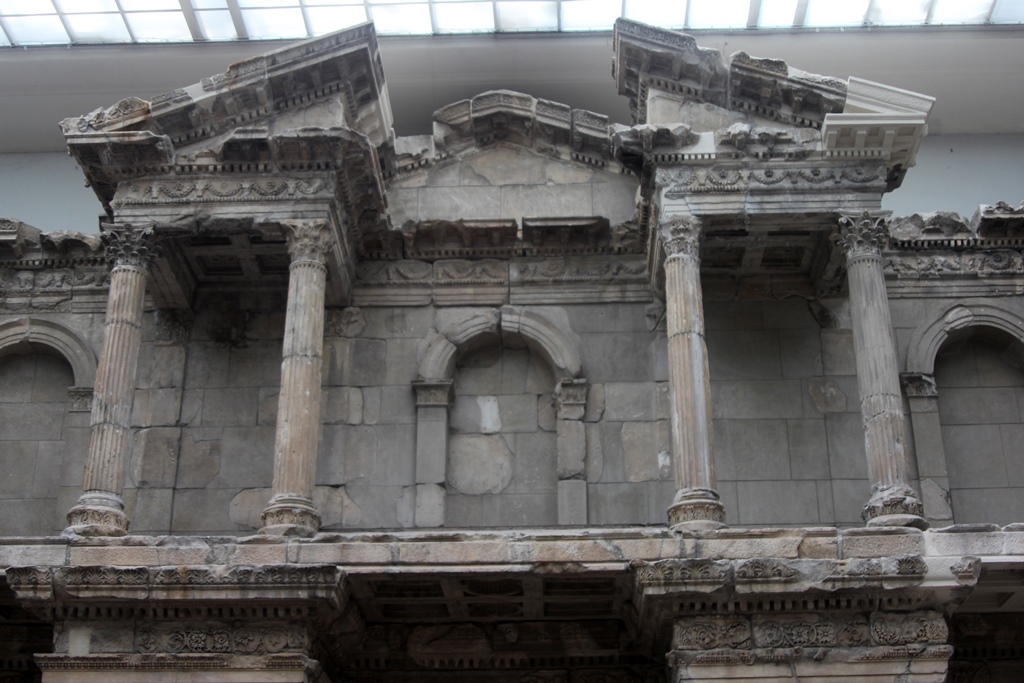
Upper Level
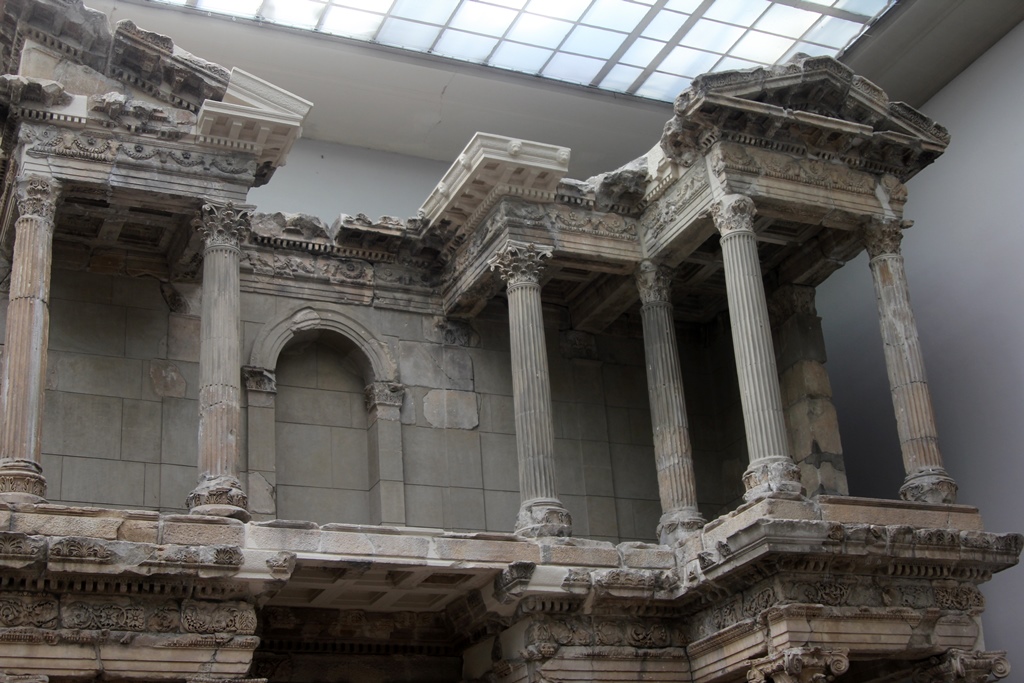
Upper Level
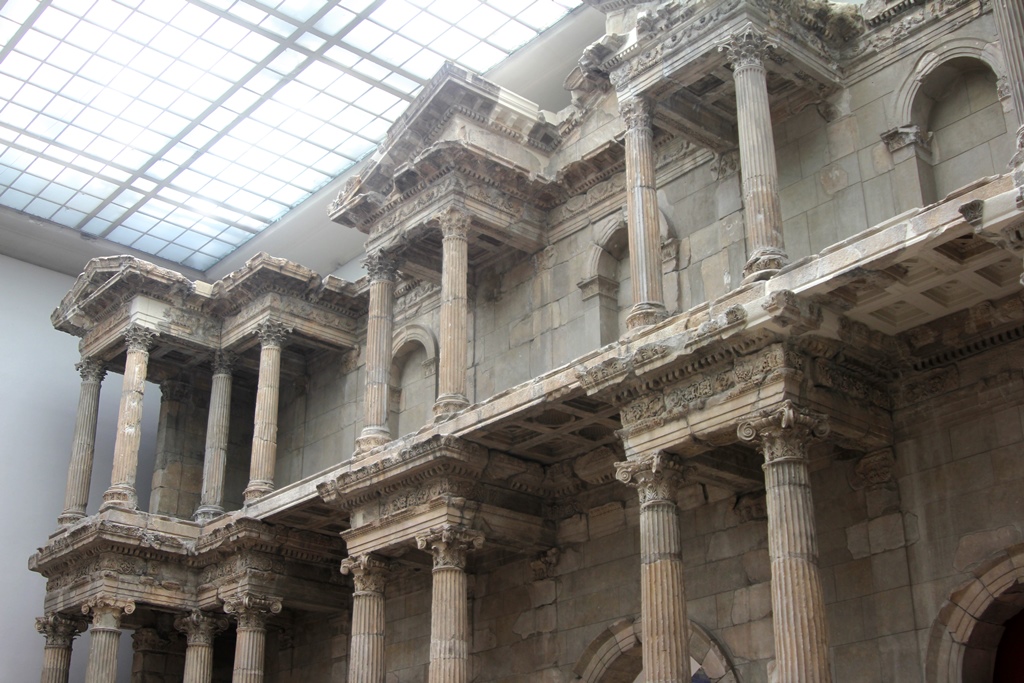
The Gate
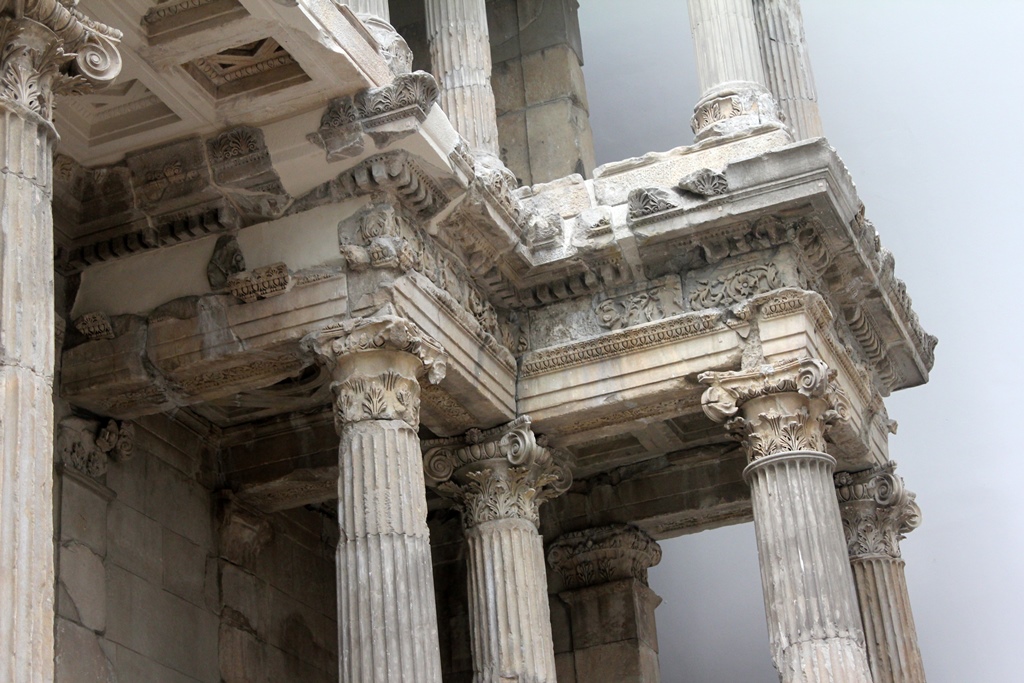
Right Section (detail)

The Gate from Below
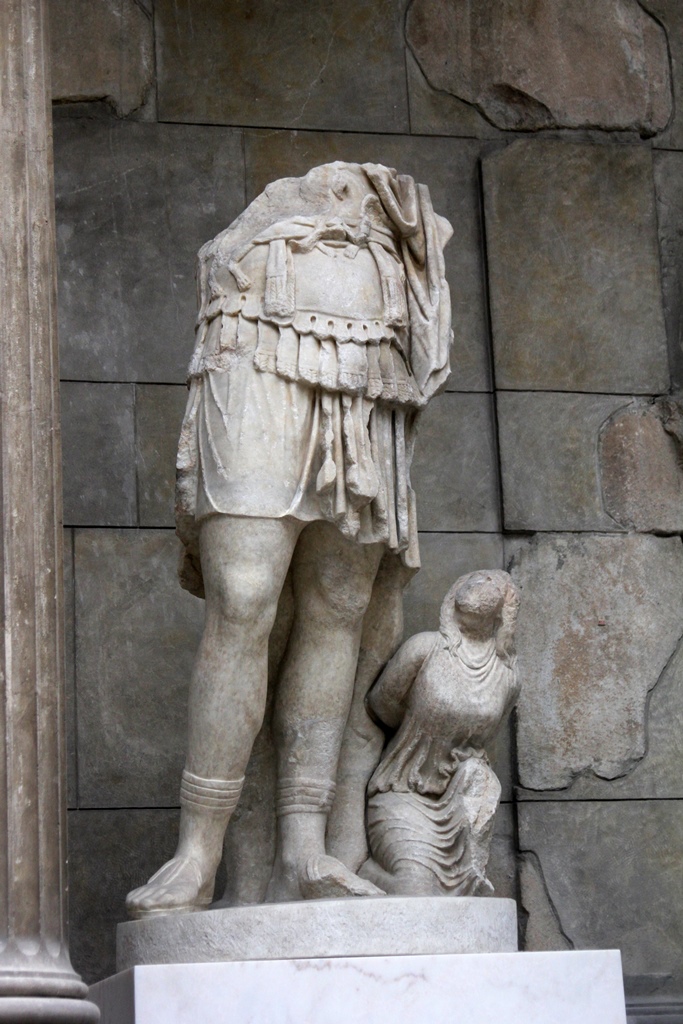
Statue of Emperor with Kneeling Barbarian
Across from the Market Gate, in the same room, were fragments from a Jupiter
Sanctuary and a balcony built from pieces from a funerary monument for a Roman
Priestess.
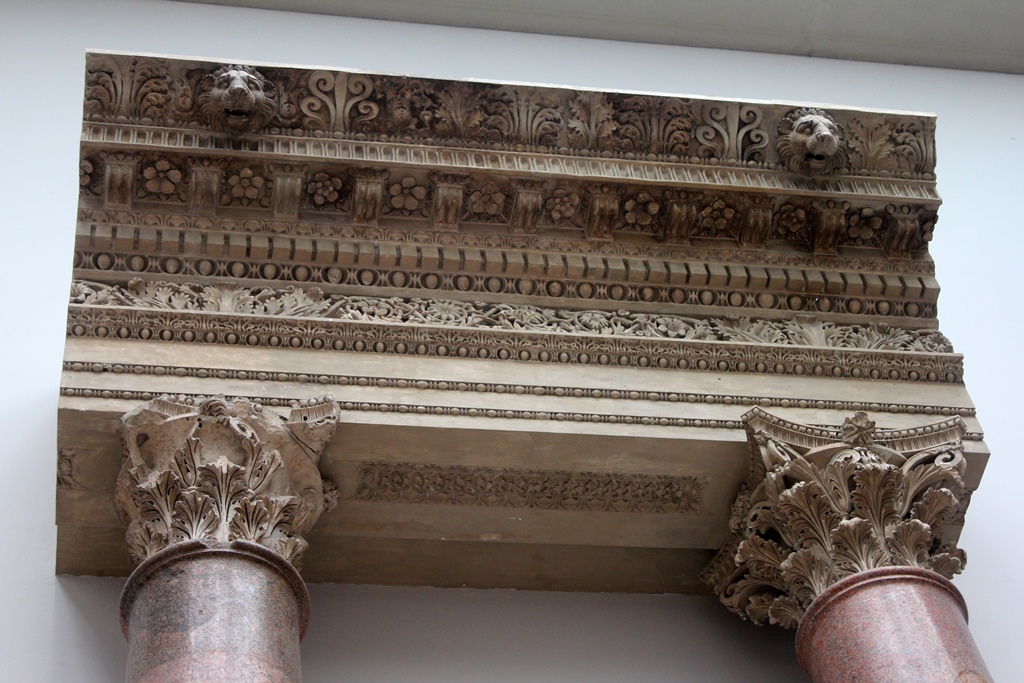
Entablature from Jupiter Sanctuary
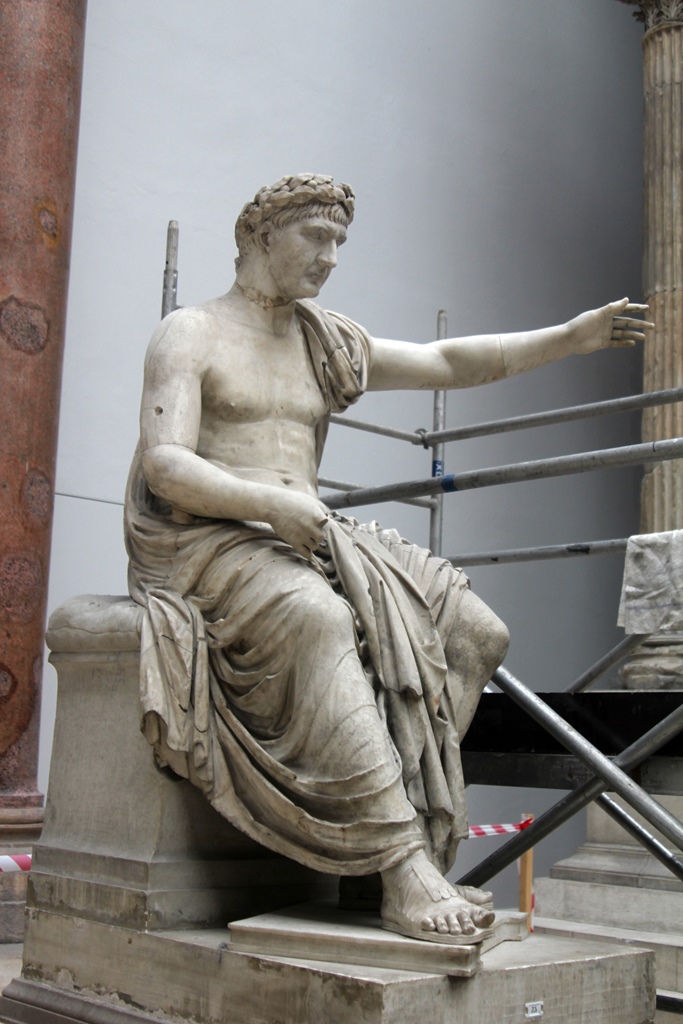
Statue of Emperor with Head of Trajan
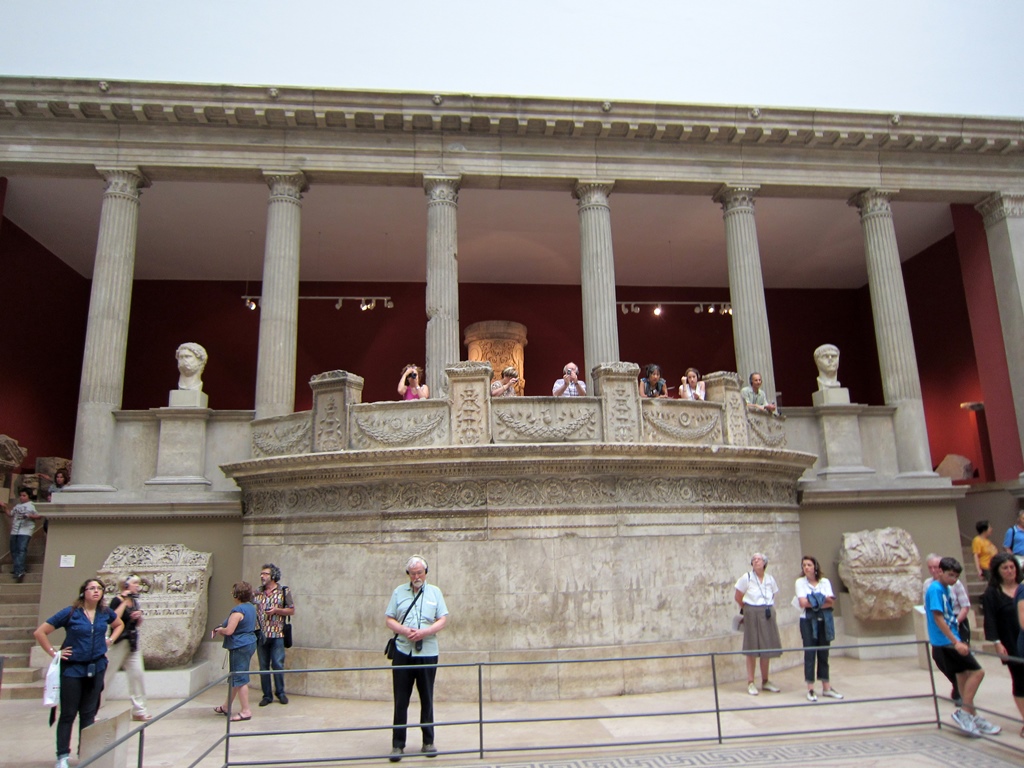
Monument of the Priestess Cartinia
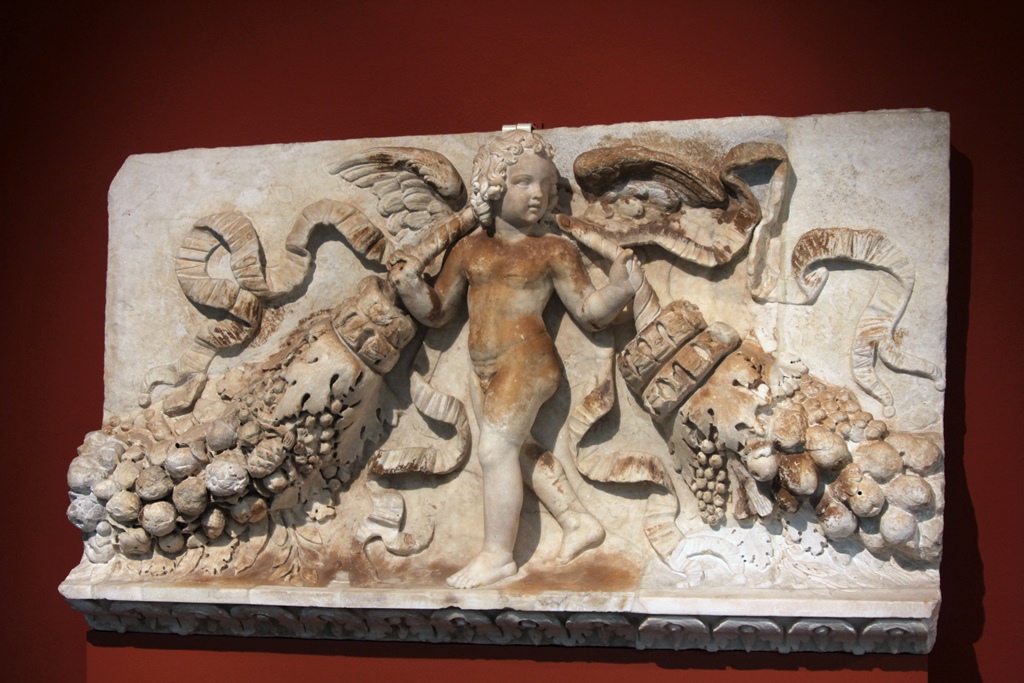
Frieze of Eros as Garland Carrier
In the Market Gate there were three doorways. The doorways on the left and on
the right were blocked off, so we passed through the one in the center, and …

